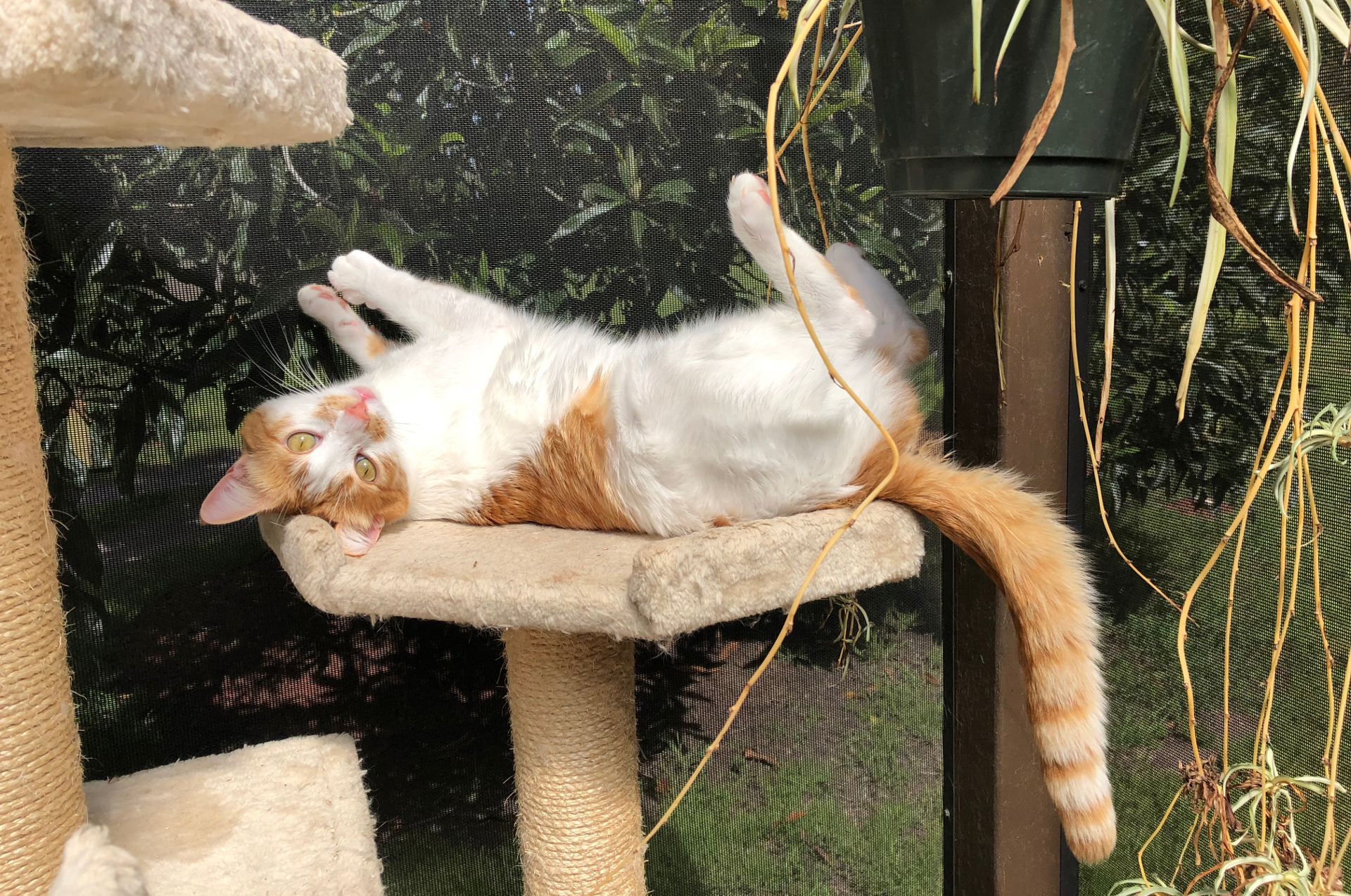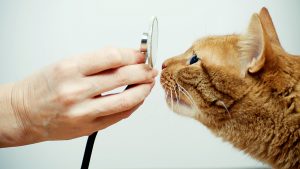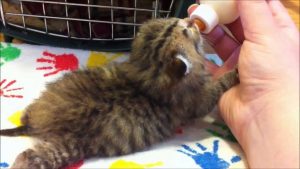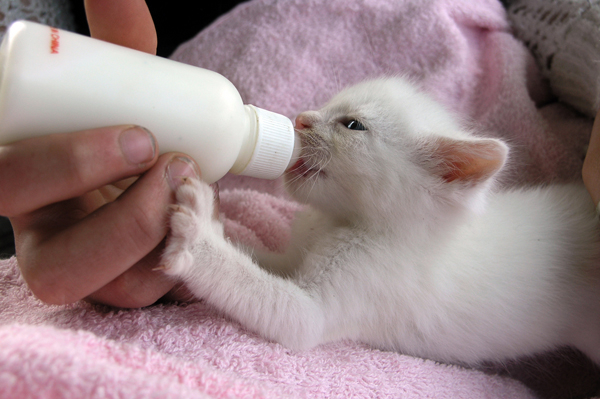Feline House Soiling
Provided by the Cornell Feline Health Center, Cornell University
House soiling is the most common behavior problem reported by cat owners. It includes urination and/or defecation outside the litter box, as well as urine spraying.
Why do cats eliminate outside of the litter box?
One common misconception is that cats soil in inappropriate places for revenge. It is tempting to conclude, “He defecated on the living room carpet to punish me for leaving him for the weekend.” But this kind of calculation requires sophisticated cognitive abilities that cats aren’t believed to possess. Furthermore, this conclusion assumes that cats view their urine and feces as distasteful, when in fact they do not. It is only we humans who view it that way.
Medical Problems
So why do cats urinate or defecate on your bed or carpet? Medical problems are one possibility. Inflammation of the urinary tract may cause painful or frequent urination, inability to urinate, bloody urine, and crying during urination. An affected cat is likely to eliminate outside the litter box if he comes to associate the box with painful urination, or if he has an increased urgency to urinate. In addition, kidney, liver, and thyroid diseases often lead to increased drinking and urination. Inflammation of the colon or rectum, intestinal tract tumors, intestinal parasites, and other gastrointestinal conditions may cause painful defecation, increased frequency or urgency to defecate, and decreased control of defecation. Age-related diseases that interfere with a cat’s mobility (for example, arthritis, nervous system disorders, or muscular diseases), or with his cognitive functions can also influence his ability to get to the litter box in time. In short, any medical condition that interferes with a cat’s normal elimination behavior can lead to house soiling.
Litter Box Aversions
Behavioral problems, such as litter box aversions, inappropriate site preferences, or urine spraying can also lead to house soiling. An aversion implies that there is something about the litter box that your cat finds unsavory. It could be the box, the litter, the location of the box, or all three.
Something about the litter box bothers your cat
Cats with aversions usually eliminate on varying surfaces. You may find puddles of urine and/or feces on either soft surfaces like carpets, beds, or clothing, or on hard, shiny surfaces like tile floors or bathtubs. Depending on the severity of your cat’s aversion, he may continue to use the litter box, but only inconsistently.
Inappropriate Site Preferences
Alternatively, your cat may develop a preference for eliminating in a spot other than the box. Preferences can be categorized as follows:
As with aversions, cats with preferences for certain surfaces or locations may continue to use the litter box inconsistently. One cause for house soiling may lead to another. For example, a cat with a urinary tract disorder that can’t make it to the litter box in time will urinate wherever she is. She may then develop a preference for the new site and continue to eliminate there.
Urine Spraying
When your cat rubs against your leg with his face, or scratches his scratching post, he is also depositing his scent from the glands in his cheeks and paws. Another equally normal but less pleasant marking behavior is urine spraying–the deposition of small amounts of urine around a given area. Spraying announces a cat’s presence, establishes or maintains territorial boundaries, and advertises sexual availability.
Cats usually spray on vertical surfaces, like the backs of chairs, or walls. They don’t squat to spray (as they do to urinate), but the tail lifts and quivers, and small puddles of urine are left in several consistent locations. Cats that spray are usually unneutered males and, to a lesser extent, unspayed females, but 10% of neutered males and 5% of neutered females also spray. In households with more than seven cats, the likelihood of spraying is high.
Cats may spray when they perceive a threat to their territory, such as when a new cat enters the home, or when outside cats are nearby. New furniture and carpet smells can prompt spraying as well. Cats may also spray out of frustration resulting from factors—like restrictive diets, or insufficient playtime—often wrongly perceived by humans as revenge.
My cat is not using the litter box reliably. What should I do?
First, address the problem promptly. The longer the behavior persists, the more likely it is to become habit. If you have more than one cat, you may need to separate them until you can identify the responsible party. Alternatively, your veterinarian can provide you with a special non-toxic stain given by mouth that will show up in the urine. In cases of defecation outside the box, you can feed one cat small pieces (about twice the size of a sesame seed) of a brightly colored non-toxic child’s crayon that will show up in the feces. If you find urine puddles in the house, it is important to distinguish between spraying and other forms of house soiling. Watch your cat for signs of spraying—or set up a video camera when you’re not around.
Once you have identified the house-soiling cat, it is wise to take him to your veterinarian for a thorough physical examination and appropriate diagnostic tests to see if there are underlying medical problems. Cats with medical conditions may not always act sick. Once medical causes have been ruled out, your detective work begins. Here are some patterns that may point to a cause:
The box itself may be the offender. Larger cats need bigger boxes, and kittens and elderly cats need boxes with low sides. Although humans like covered boxes for reducing odor and stray litter, from your cat’s point of view, covers hold odors in, and restrict his view of the area. You may need to purchase several types of boxes and several types of litter to determine which combination your cat likes best. Finally, provide as many boxes as there are cats in the house—plus one. For example, if you have two cats, there should be three litter boxes. This decreases competition and gives each cat a box of his or her own.
How can I stop my cat from spraying?
Because spraying is different than other types of house soiling, different tactics are necessary to manage it. First, because there are often hormonal components to spraying, any intact animal should be neutered or spayed. Next, identify the stimuli that cause your cat to spray. If outside cats are responsible, motion detectors that trigger sprinklers can be used to deter them from coming onto your property. Additionally, you can discourage your cat from looking outside by closing blinds or shades, or by placing double-sided tape or electronic mats that deliver mild shocks onto your windowsills. Address possible sources of frustration that may be causing your cat to spray. For example, introduce a new diet gradually, or discontinue it until the spraying is under control. Increasing the amount of playtime for an under-stimulated cat may also help ease frustration.
Spraying can also result from territorial disputes between cats in the same household. They may need to be separated and reintroduced slowly, using food treats to reward and encourage peaceful behavior.
Applying odor neutralizers anywhere your cat has sprayed may prevent him from spraying there again. Another useful commercial product is Feliway®, a synthetic pheromone that, when applied to household surfaces, mimics the scent of cat cheek gland secretions. Many cats will not spray on areas that have this scent. (See the end of this brochure for information on where to purchase the above-mentioned products.)
Will medications stop my cat from house soiling?
Spraying is more responsive to anti-anxiety drugs than other types of house soiling. However, medication is only part of the solution, and must be used in conjunction with environmental changes. Any medication can have potentially damaging and/or unwanted side effects, and not all cats are good candidates. Cats placed on long-term medication must be monitored closely by a veterinarian.
What can I use to clean my cat-soiled carpet, couch, and other household items?
Cats will re-soil and spray areas previously impregnated with their scent. Therefore, cleaning up your cat-soiled belongings is important, not only to undo the damage, but to break the cycle of elimination. Because it is much easier to eliminate odors in recently-soiled areas, clean them as soon as possible. A cat’s sense of smell is far keener than ours; therefore odors must be neutralized, not just deodorized. However, avoid cleaning products containing ammonia or vinegar—they smell like urine and can be irritating.
What other methods should I consider?
Conclusion
A common and frustrating problem, inappropriate elimination can be difficult to control. A full resolution depends on early intervention, followed by detective work to determine the cause of the behavior, and time and effort on your part to solve the problem. In partnership with veterinarians, both cats and the people who love them can live in harmony and good health.
Helpful hints for preventing litter box problems
1. Choosing an appropriate litter and box
2. Choosing a good litter box location
3. Keeping the box clean
Suggested cleaning products and resources
Cleaners/Deodorizers
Anti-Icky-Poo (AIP)
Bug-A-Boo Chemicals
11924 NE Sumner
Portland, OR 97220
Nature’s Miracle
Pets ‘N People Inc.
27520 Hawthorne Boulevard, Suite 125
Rolling Hills Estates, CA 90274
(Also available at most major pet stores)
Outright Stain and Odor Removal Products
The Bramton Company
P.O. Box 655450
Dallas, TX 75265-5450
Oxyfresh Pet Deodorizer
Oxyfresh USA, Inc.
P.O. Box 3723
Spokane, WA 99220
Pheromone Spray
Feliway
Abbott Laboratories
1401 North Sheridan Road
North Chicago, IL 60064
Electronic Mats
Scatmat/Scarecrow Motion Activated Sprinklers
Contech Electronics, Inc.
P.O. Box 115
Saanichton, British Columbia
Canada V8M 2C3
PetMat Radio Systems Corporation
5008 National Drive
Knoxville, TN 37914
Motion Detectors
Scarecrow
The Dog’s Outfitter
1 Maplewood Drive
Hazleton, PA 18201
(Motion detector that turns on a sprinkler when activated)

















